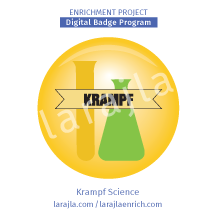 Robert Krampf is the “Happy Scientist.” He has taught science, done a science road show and been on the Web for a very long time. His goal is to make science fun for kids. Let’s explore how he does this.
Robert Krampf is the “Happy Scientist.” He has taught science, done a science road show and been on the Web for a very long time. His goal is to make science fun for kids. Let’s explore how he does this.
Steps
1. Robert Krampf.
Find out about Robert Krampf. What kind(s) of science does he do? How did he become a leader in his field?
2. Happy Scientist.
Visit Krampf’s web site and peruse his science experiments for kids. Which do you think kids would be interested in trying? If you would like, check out his free stuff on his site.
3. Videos.
Check out some of Krampf’s videos on YouTube to help get you excited about science. Be sure to note any you’d like to do with your kids.
4. Safety.
Before doing experiments, make sure you are safe. Make a list of safety equipment you need. If you are working with chemicals, make sure you know what to do in case of an emergency.
5. Experiment.
Try an experiment, or more than one, you think kids might like. Make sure you understand the science behind the experiment. If you make any adjustments, be sure to keep track of it so you can duplicate your results with your kids.
6. Themes.
Doing a single experiment is cool, but putting them together gives a greater view to a scientific concept. Create a “theme” by putting two or more experiments together. Check to make sure they all work with your theme to give a better understanding of the concept you’re trying to communicate.
7. Do it!
Get a group together to do the experiment(s). Make sure you have all safety precautions in place and explained to the group.
NOTE: If you didn’t do the experiment before presenting it, you don’t know what will happen and you’ll be unable to tell if the experiment was a success. Always do the experiment before presenting it.
8. Anywhere.
Experiments do not have to be done in a specific setting. Find experiments that you can take on a camp out, do at a party, etc. How can you present it to be more “fun”?
9. Science.
Discuss the science behind the experiment with the group. Don’t give them all the answers. Let them figure it out from the experiments they just did. This is part of the experiment.
10. Explore.
Share the information for Krampf’s science experiments. If you’re meeting your group again, ask them to find an experiment that interests them to bring back to the group. You may want to assign groups to do a single experiment and give them a date when they will be presenting. Use this as an opportunity for them to not only share, but lead as well.
Supplements
SUPP_Krampf Science_2in_12up_larajla
- Avery 2.5” round label printable, 12 up
SUPP_ Krampf Science_Checklist_larajla
- Badge checklist
Sites to Explore
- thehappyscientist.com
- thehappyscientist.com/videos
- www.youtube.com/watch?v=YwYEy5AXwlQ
- www.youtube.com/watch?v=OEdlOt87bQI
- en.wikipedia.org/wiki/Robert_Krampf
- www.learnoutloud.com/Podcast-Directory/Science/Archaeology/Experiment-of-the-Week-Video-Podcast/30213
- www.facebook.com/TheHappyScientist
Get the infographic here > larajla blog post
Get the PDFs of the badge program / supplements here > Full badge PDFs